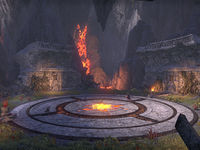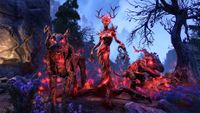Lore:Dreadhorn Clan
The Dreadhorn Clan was a Reachfolk group of the Keptu origins, that was active in 2E 582. They made an alliance with powerful minotaur warlord Domihaus the Bloody-Horned.[1] After forming the alliance they uncovered the long forgotten Bloodroot Forge[2] and besieged Falkreath. Many of the members of the clan went through arcane ritual that empowered them and turned into powerful warriors known as Blood Forged.[3] They worshipped Hircine, made pacts with Cernunnon and utilized magic related to Kyne.[3][UOL 1]
The Bloodforge Smiths were the Reachfolk of the Dreadhorn Clan who worked the ancient Bloodroot Forge. Both the clan leader Gherig Bullblood and Stoneheart the Heartstone outlined the sacred schema that defined the trappings of the Bloodforge Smiths and the Dreadhorn clansmen as a whole.[4][5][6]
History[edit]
Ancient Past[edit]
Most Nedic cultures were in decline by the time the Ra Gada set foot in Volenfell circa 1E 808.[7] Keptu had cultural interchange with the clans of the Reach, who adopted parts of their cultural styles.[8] The Dreadhorn Clan descends from the ancient people of Keptu origin.[1]
Second Era[edit]
Sometime during the early years of the Interregnum, Gherig Bullblood's Reachmen clan followed the signs laid by their Crow Mother for 30 days and nights, tracing crow-picked corpses through the Jerall Mountains, until finally, Hircine revealed to them his champion.[1] The champion was the minotaur known as Domihaus the Bloody-Horned, who grabbed Gherig by the neck, taking from him his pendant, which indicated that he was a descendant to the Keptu clan. Noting his heritage, Domihaus began a chant, making the stones reshape, and initiated a blood ritual which both Domihaus and Gherig took part in. This ritual linked Gherig to the home of his ancient ancestors, a home which called to him to rediscover it. With the union of blood, Gherig's clan was reborn as the Dreadhorn Clan, which revered Hircine through his champion Domihaus,[5] whom the clan hoped would lead them to reclaim the lands their ancestors lost to the Nords.[1]
The Dreadhorn Clan traveled to Craglorn and discovered Hircine's Boon, the Bloodroot Forge, and began to work it. Any settlers near the area were either sacrificed or enslaved, and forced to mine nirncrux to feed the forge. It is known that weapons of great power were created using the forge.[9] Weaponry and armor of the clan members reflected their allegiance to tradition as well as to their newfound minotaur allies. The quality of their weaponry and armor was high—they used properly forged weapons and armor and often adorned their weapons with ornaments. They considered the bull to be their emblem after beginning their alliance with the minotaurs and embellished their belongings with bull symbolism. Their clothing and weapons was ornamented with imagery of bull and the coiled vine. They were also known for their traditional signature kilts made of leather.[4][5] The bull imagery is not limited to items—the members of the clan pay homage to the strength of their minotaur allies with intricate tattoos.[10][11]
Dreadhorn Clan members utilized Hircine's Bloodroot Forge to create nirnblooded creatures.[12][13] The human members of the clan as well as minotaurs turned themselves into the Blood-Forged. They are comparable to Briarhearts, but their creation instead involves a nirncrux heartstone being used in place of a briar heart,[14] resulting in a being that is an amalgamation of blood, nirncrux, and iron.[15] The shamans of the Dreadhorn Clan were known for painting symbols using nirncrux powder and blood on their skin for the purposes of various rituals.[16] Spigots crafted from the hollowed horns of minotaurs, and adorned with intricate engravings featuring the symbols of the clan were employed to extract blood from sacrifices dedicated to Hircine.[17]
By 2E 582, the Dreadhorn Clan were greatly emboldened by the Bloodroot Forge, and Domihaus led an organized attack on Falkreath Hold. The Dreadhorn Clan and their minotaur allies utilized relatively advanced siege weapons[3] and the power of shamanistic Kyne-magic during their assault.[UOL 1]
The Jarl of Falkreath took to hiding in his longhouse. His daughter and thane, Eerika Skjoralmor, led the remnants of the resistance.[18] She held the town for some time until the intervention of the Undaunted, who crossed the battlefield and aided the thane in her effort to save the city. The group was able to defeat Domihaus at the jarl's keep and witness the coronation of Jarl Eerika.[3]
With Hircine's forge shut down and his champion Domihaus slain, the Dreadhorn Clan was devastated. Members of the Undaunted speculated that since the forge was uncovered, it was unlikely that it would remain unclaimed.[19] Gherig Bullblood remained in the forge to continue creating terrible weapons. The threat of the Dreadhorn Clan grabbed the attention of the Undaunted, which led to an assault on the forge, and the death of Gherig Bullblood.[2] However, the forge called to all that within its boundaries to dwell in crazed and feral thoughts, clamoring for blood.[14] Their Dreadhorn Clan's victims felt compelled to use the forge to seek revenge on the Reachmen, reversing the roles of hunter and prey.[20]
The significance of the Dreadhorn Clan allowed them to be documented within the Infinite Archive in Apocrypha. There, copies of them were subsequently created as maligraphies, creatures composed of vivified ink manifested by stories from books, and serve as mindless extensions of the Daedric Lord Tho'at Replicanum.[21][22][23]
See Also[edit]
- For game-specific information, see the Elder Scrolls Online
 article.
article.
Books[edit]
- Nicolard's Notes on the Forge by Nicolard Lia — A researcher's notes on an ancient Nedic forge
- Nicolard's Notes on Ruin Origins by Nicolard Lia — A researcher's notes on the Bloodroot Forge
- Meet the Character - Domihaus the Bloody-Horned by Gherig Bullblood — An intercepted message from a Reachman patriarch
Gallery[edit]
References[edit]
- ^ a b c d Meet the Character - Domihaus the Bloody-Horned — Gherig Bullblood
- ^ a b Events of Blood for Blood in ESO
- ^ a b c d Events of Falkreath's Demise in ESO
- ^ a b Crafting Motif 54: Bloodforge Style — Stoneheart the Heartstone
- ^ a b c Crafting Motif 55: Dreadhorn Style — Gherig Bullblood of the Dreadhorn Clan [Notes by Rena Hammerhands]
- ^ Crown Store Showcase of Bloodforge Style
- ^ Nedes of the Deathlands — Argus Mender
- ^ Keptu-Horn Skull Sallet hat description
- ^ Horns of the Reach and Update 15 Preview
- ^ Dreadhorn Face Tattoo head marking description in ESO
- ^ Dreadhorn Body Tattoo body marking description in ESO
- ^ Nirnblooded Bear, Nirnblooded Guar and other creatures in ESO
- ^ Horns of the Reach – Bloodroot Forge Preview
- ^ a b Filand's dialogue in ESO
- ^ Blood-Forged skin description in ESO
- ^ Dreadhorn Shaman skin description in ESO
- ^ Minotaur Horn Spigot item description in ESO: Greymoor
- ^ Beware of Falkreath — Jofnhild
- ^ Urgarlag Chief-bane's dialogue in ESO
- ^ Rena Hammerhands' dialogue in ESO
- ^ Loremaster's Archive - Infinite Archive — Master Malkhest
- ^ Master Malkhest's dialogue in ESO: Necrom
- ^ Enemies in Infinite Archive in ESO
Note: The following references are considered to be unofficial sources. They are included to round off this article and may not be authoritative or conclusive.
- ^ a b Developer comments on the Dreadhorn Clan (24:40) on ESO Live









